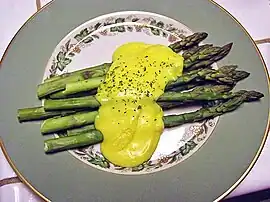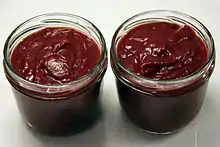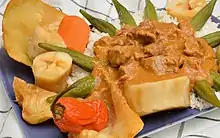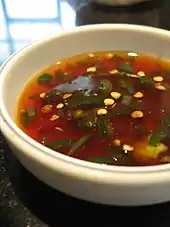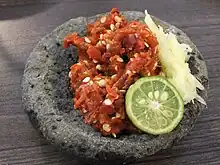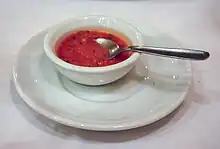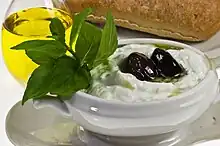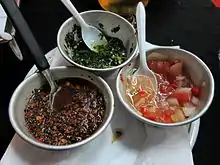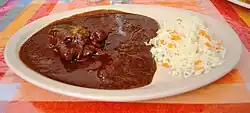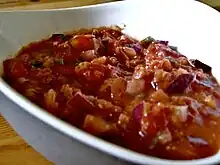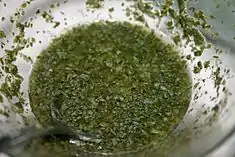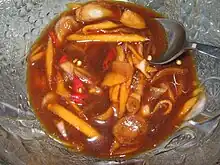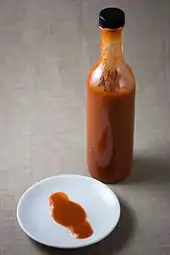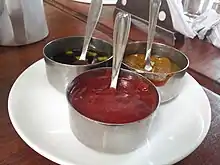

The following is a list of notable culinary and prepared sauces used in cooking and food service.
General
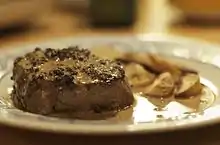
- Anchovy essence – Thick, oily sauce of pounded anchovies and spices
- Avgolemono – Egg-lemon sauce or soup
- Avocado sauce – Sauce prepared using avocado as a primary ingredient
- Barbecue sauce – Sauce used as a marinade, basting, topping, or condiment[1]
- Bread sauce – Sauce made with milk and bread crumbs
- Cheese sauce – Sauce made with cheese
- Cocktail sauce – Condiment
- Coffee sauce – Culinary sauce that includes coffee
- Corn sauce
- Coulis – Thin sauce made from vegetables or fruits
- Duck sauce – American Chinese condiment with a translucent orange appearance
- Egusi sauce
- Fry sauce – Condiment for French fries
- Mahyawa – Sauce
- Mignonette sauce – Condiment served with oysters
- Mint sauce – Sauce made of chopped mint
- Mushroom ketchup – Style of ketchup
- Normande sauce
- Pan sauce – Cooking technique to create a sauce
- Peppercorn sauce – Culinary cream sauce
- Rainbow sauce – Type of culinary sauce
- Ravigote sauce
- Romesco – Catalan sauce of tomatoes, garlic, and nuts
- Salad dressing – Food mixture, served chilled or at room temperature
- Salsa – Condiment used in Mexican cuisine (salsa roja)
- Satsebeli
- Sauce andalouse – Belgian sauce
- Sauce aurore – a velouté sauce flavored with tomato[2]
- Sauce bercy – French sauce
- Sauce poulette – prepared using mushrooms and lemon[3]
- Sauce vin blanc
- Sofrito – Cooked vegetable foundation for cooking
- Steak sauce – Brown sauce for seasoning of steaks
- Sweet chili sauce – Condiment primarily used as a dip
- Tomato sauce – Sauce made primarily from tomatoes
- Vinaigrette – Sauce made from oil and vinegar and commonly used as a salad dressing
- Wine sauce
- Worcestershire sauce – English fermented condiment
Prepared sauces
- A.1. Sauce – Brand of brown sauce condiment
- Alfredo sauce – Italian pasta dish with butter and cheese
- Baconnaise – Brand of bacon-flavored condiment
- Cheez Whiz – Trademarked processed cheese
- Daddies – Brand of ketchup and brown sauce
- HP sauce – British sauce made with tamarind
- Ketchup – Sauce used as a condiment
- Maggi – International food brand
- Magic Shell – Dessert topping
- McDonald's sauces
- Mustard (condiment) – Condiment made from mustard seeds
- OK Sauce – Brand of brown sauce
- Pickapeppa Sauce
- Salsa Lizano – Costa Rican condiment
- Salsa (prepared) – Condiment used in Mexican cuisine
- Tapatío hot sauce – American hot sauce
- Prego – American pasta sauce brand
By type
Brown sauces

Brown sauces – Sauce made with brown meat stock include:
- Bordelaise sauce – French wine sauce
- Chateaubriand sauce – Front cut of a beef tenderloin
- Charcutiere sauce – Compound French sauce
- Chaudfroid sauce – French culinary sauce[4]
- Demi glace – Sauce in French cuisine
- Gravy – Sauce made from the juices of meats
- Mushroom gravy
- Romesco sauce – Catalan sauce of tomatoes, garlic, and nuts
- Sauce Africaine – French sauce, consisting of sauce espagnole with tomatoes, onions, peppers and herbs
- Sauce au Poivre
- Sauce Robert – French sauce consisting of onions, white wine, pepper, demi-glace, and mustard[5]
Butter sauces
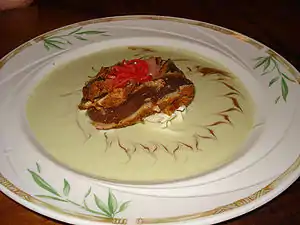
- Beurre blanc – Emulsified butter sauce
- Beurre manie – Thickening agent
- Beurre monté
- Beurre noisette
- Café de Paris – Butter-based sauce
- Meuniere sauce – French brown butter, parsley, and lemon sauce
Emulsified sauces

- Aioli – West Mediterranean sauce of garlic and oil
- Béarnaise sauce – Sauce made of clarified butter and egg yolk
- Garlic sauce – Sauce with garlic as a main ingredient
- Hollandaise sauce – Sauce made of egg, butter, and lemon[6]
- Mayonnaise – Thick cold sauce
- Remoulade – Mayonnaise-based cold sauce[7]
- Salad cream – Dressing similar to mayonnaise
- Tartare sauce – Mayonnaise-based cold sauce(w/ chilli)[8]
Fish sauces
- Bagna càuda – Italian hot dish made from garlic and anchovies
- Clam sauce – Pasta sauce
- Colatura di alici – Italian fish sauce made from anchovies fermented in brine
- Garum – Historical fermented fish sauce
Green sauces
- See Green sauce – Sauce made from chopped herbs
Tomato sauces
- Tomato sauces – Sauce made primarily from tomatoes
- Ketchup – Sauce used as a condiment
Hot sauces
- Pepper sauces
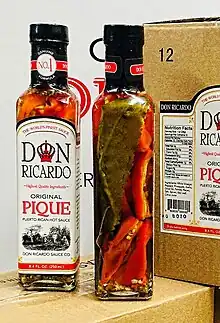
- Mustard sauces
- Mustard – Condiment made from mustard seeds
- Chile pepper-tinged sauces
.jpg.webp)
- Hot sauce – Condiment made from chili pepperss include:
- Buffalo Sauce – American dish of spicy chicken wings
- Chili sauce – Condiment prepared with chili peppers
- Datil pepper – Variety of chili pepper sauce
- Enchilada – Corn tortilla rolled around a filling and covered with a sauce sauce
- Pique Sauce
- Sriracha sauce – Thai hot sauce
- Tabasco sauce – American hot sauce brand
Meat-based sauces

- Amatriciana sauce – Traditional Italian pasta sauce
- Barese ragù – City in Apulia, Italy
- Bolognese – Italian pasta sauce of meat and tomatoes
- Carbonara – Italian pasta dish
- Cincinnati chili – Spiced meat sauce used as a topping for spaghetti
- Neapolitan ragù – Italian meat sauce
- Picadillo – Ground meat and tomato dish popular in Latin America and the Philippines
- Ragù – Meat-based sauce in Italian cuisine
Pink sauces
- See Pink sauce
Sauces made of chopped fresh ingredients

- Chimichurri – Uncooked sauce for meat
- Gremolata – Condiment for ossobuco
- Mujdei – Spicy Romanian sauce made mostly from garlic and vegetable oil
- Onion sauce
- Persillade – Sauce or seasoning mix
- Pesto – Sauce made from basil, pine nuts, parmesan, garlic, and olive oil
- Pico de gallo – Mexican condiment
- Latin American Salsa cruda of various kinds
- Salsa verde – Spicy Mexican sauce based on tomatillos
- Sauce gribiche – Cold egg sauce
- Sauce vierge – French sauce
- Tkemali – Georgian plum sauce
Sweet sauces

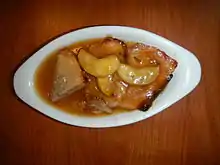
- Apple sauce – Purée made from apples
- Blueberry sauce – Compote or savory sauce made with blueberries
- Butterscotch sauce – Type of confectionery
- Caramel – Confectionery product made by heating sugars
- Chocolate gravy – Gravy made with cocoa powder
- Chocolate syrup – Chocolate-flavored condiment used as a topping or ingredient
- Cranberry sauce – Sauce or relish made from cranberries
- Crème anglaise – Light sweetened pouring custard
- Custard – Semi-solid cooked mixture of milk and egg
- Fudge sauce – Chocolate-flavored condiment used as a topping or ingredient
- Hard sauce – Dessert sauce of sugar, butter, and spirits – not liquid, but called a sauce nonetheless
- Sweet chili sauce – Condiment primarily used as a dip
- Mango sauce – Species of fruit
- Peach sauce
- Plum sauce – Chinese condiment
- Strawberry sauce
- Syrup – Thick, viscous solution of sugar in water
- Tkemali – Georgian plum sauce
- Zabaione – Italian dessert made with egg, sugar, and wine
White sauces

- Alfredo sauce – Italian pasta dish with butter and cheese
- Béchamel sauce – Sauce of the Italian and French cuisines[9]
- Caruso sauce – Cream sauce for pasta
- Mushroom sauce – White or brown sauce prepared with mushrooms
- Mornay sauce – Type of béchamel sauce including cheese
- Sauce Allemande – Sauce used in classic French cuisine
- Sauce Américaine – sauce from classic French cuisine
- Suprême sauce – Classic French sauce
- Velouté sauce – Classic French sauce
- Yogurt sauce – Food produced by bacterial fermentation of milk
By region
Africa
Sauces in African cuisine include:
Asia
East Asian sauces
Sauces in East Asian cuisine include:
- Doubanjiang – Chinese spicy bean paste ingredient
- Doenjang – Korean fermented bean paste
- Gochujang – Spicy fermented Korean condiment
- Hoisin sauce – Sauce commonly used in Chinese cuisine
- Mala sauce – Spicy Chinese seasoning
- Mirin – Type of rice wine used in Japanese cuisine
- Oyster sauce – Condiment made by cooking oysters
- Plum sauce – Chinese condiment (Chinese; see umeboshi paste below for Japanese pickled plum sauce)
- Ponzu – Japanese citrus-based condiment
- Soy sauce – East Asian liquid condiment
- Sweet soy sauce – Sweetened aromatic soy sauce, originating from Java, Indonesia
- Ssamjang – Spicy soybean paste used in Korean cuisine
- Tentsuyu – tempura dipping sauce
- Umeboshi paste – Sour, pickled Japanese fruit, or Japanese pickled plum sauce, a thick sauce from a fruit called a plum in English but which is closer to an apricot
- XO sauce – Spicy seafood sauce from Hong Kong
- Cooked sauces
- Lobster sauce – type of sauce used in American-Chinese and Canadian-Chinese cuisine, made of chicken broth, garlic, ginger, fermented black beans, eggs, and cornstarch; does not contain any lobster, despite the name
- Shacha sauce – Chinese condiment
- Siu haau sauce – thick, savory, slightly spicy sauce generally known as the primary barbecue sauce used within Chinese and Cantonese cuisine
- Sweet and sour sauce – Cooking method
- Sweet bean sauce, also known as Tianmianjiang – Sweet savory sauce used in Chinese and Korean cuisines
- Teriyaki – Japanese marinade – a way of cooking in Japan, a branch of sauces in North America
Southeast Asian sauces
Sauces in Southeast Asian cuisine include:

- Budu – Fish sauce originating from east coast of Peninsular Malaysia
- Fish sauce – Condiment made from fish
- Mắm nêm – Condiment
- Nam chim – Thai sauce
- Nam phrik – Thai chili sauce
- Nước chấm – Vietnamese dipping sauce
- Padaek – Traditional Lao condiment made from pickled or fermented fish that has been cured
- Pecel – Indonesian vegetable dish
- Pla ra – Southeast Asian fermented fish seasoning
- Sambal – Indonesian spicy relish or sauce
- Peanut sauce, also known as Satay sauce – Indonesian sauce made from ground roasted or fried peanuts
- Saus cabai – Condiment prepared with chili peppers
- Sriracha sauce – Thai hot sauce
- Sweet soy sauce – Sweetened aromatic soy sauce, originating from Java, Indonesia
- Tương
Caucasus
Sauces in Caucasian cuisine include:
Mediterranean
Sauces in Mediterranean cuisine include:

- Garum – Historical fermented fish sauce
Middle East
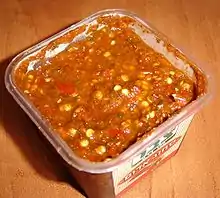
Sauces in Middle Eastern cuisine include:
South America
Sauces in South American cuisine include:
- Ají (sauce) – Ají-based condiment traditional in Andean cuisine
- Caruso sauce – Cream sauce for pasta
- Chancaca – Sweet sauce traditional to southern Andean cuisine
- Chimichurri – Uncooked sauce for meat
- Hogao – Colombian style sofrito
- Tucupi – Sauce used in Brazilian cuisine, extracted from the Cassava root
By country
Argentina

Sauces in Argentine cuisine include:
- Caruso sauce – Cream sauce for pasta
- Chimichurri – Uncooked sauce for meat
- Salsa golf – Cold sauce of mayonnaise and tomatoes[10]
- Salsa criolla – Type of salad or relish found in Latin American cuisine
Barbados
Sauces in the cuisine of Barbados include:
- Bajan pepper sauce – type of condiment[11]
Belgium
Sauces in Belgian cuisine include:
- Andalouse sauce – a mildly spiced sauce made from mayonnaise, tomatoes and peppers
- Brasil sauce – mayonnaise with pureed pineapple, tomato and spices[12]
- Zigeuner sauce – cuisine 'gypsy style' – A "gypsy" sauce of tomatoes, paprika and chopped bell peppers, borrowed from Germany
Bolivia
Sauces in Bolivian cuisine include:
- Llajwa – Bolivian spicy sauce
Brazil
Sauces in Brazilian cuisine include:
Canada
Sauces in Canadian cuisine include:
- Donair sauce – Canadian restaurant chain
- Honey garlic sauce
Chile
Sauces in Chilean cuisine include:
- Pebre – Chilean condiment
- Salsa Americana – Chilean relish made of pickles, pickled onions, and pickled carrots
China
- Light soy sauce (生抽) – a lighter-colored salty-flavored sauce used for seasoning and not as a dipping sauce
- Dark soy sauce (老抽) – a darker-colored sauce used for color
- Seasoned soy sauce – usually light soy sauce seasoned with herbs, spices, sugar, or other sauces
- Sweet bean sauce (甜面酱) – a thick savory paste
- Oyster sauce (蚝油)
- Fermented bean curd (腐乳) – usually cubes of tofu, and sometimes other spices and seasonings, which are used as a condiment or marinade along with some of the brine
- Douchi (豆豉) – fermented black beans, usually in a brine
- Cooking wine (料酒)
- Black vinegar (陈醋)
- Cha Shao sauce (叉烧酱, Cantonese: Char Siu)
- Duo Jiao (剁椒) - chili sauce.
- Ci Ba La (糍粑辣) - a chili sauce.
- Zao La (糟辣) - a chili sauce.
- Lao Guo La (烙锅辣) - a chili sauce. One famous brand is Lao Gan Ma.
- Rib sauce (排骨酱)
- Chili oil (红油) – usually made by pouring hot oil that's been seasoned with spices onto ground chili flakes and left to steep
- Doubanjiang (豆瓣酱) – a mix of fermented beans, chilis, salt, and flour used for flavor and color
- Soy bean Paste / Yellow bean paste (黄酱)
- Fish sauce (鱼露)
- Garlic chive flower sauce (韭花酱)
- Guaiwei (怪味)
- Haixian sauce (海鲜酱, Cantonese: Hoisin)
- Plum sauce (苏梅酱)
- Sesame oil (香油)
- Sesame Paste (麻酱)
- Mala (麻辣)
- Shao Kao sauce (烧烤酱, Cantonese: Siu Haau) – a thick, savory, slightly spicy BBQ sauce generally known as the primary barbecue sauce used within Chinese and Cantonese cuisine.
- Shacha sauce (沙茶酱) – A sauce or paste that is used as a base for soups, hotpot, as a rub, stir fry seasoning and as a component for dipping sauces.
- Soy sauce paste
- White vinegar (白醋)
- XO sauce (XO酱) – a spicy seafood sauce that originated from Hong Kong.[13]
- Yongfeng chili sauce (永丰辣酱)
- Yuxiang (魚香)
Colombia
Sauces in Colombian cuisine include:
- Hogao – Colombian style sofrito
Denmark
Sauces in Danish cuisine include:
- Persillesovs – cream sauce seasoned with parsley – a key ingrediant in the Danish national dish Stegt flæsk med persillesovs
- Brun sovs – Sauce made with brown meat stock
England
Sauces in English cuisine include:
France
Sauces in French cuisine include:
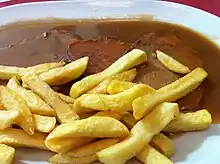
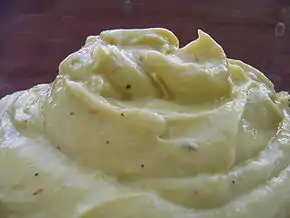
- Allemande – Veal stock, veal velouté, lemon juice, mushrooms and egg yolks.[14]
- Américaine – Mayonnaise, blended with puréed lobster and mustard.[15]
- Béarnaise – Reduction of chopped shallots, pepper, tarragon and vinegar, with egg yolks and melted butter.[16]
- Bercy – Chopped shallots, butter and white wine, with either fish stock or meat stock.[16]
- Béchamel – milk-based sauce, thickened with a white roux.
- Beurre blanc – Reduction of butter, vinegar, white wine and shallots.[17]
- Beurre maître d'hôtel – Fresh butter kneaded with chopped parsley, pepper and lemon juice.[18]
- Beurre noir – Browned butter with lemon juice/vinegar and parsley; traditionally served with raie (Skate).[19]
- Beurre noisette – Lightly browned butter with lemon juice.[20]
- Beurre vert – Butter mixed with the juice extracted from spinach.[21]
- Bordelaise – Chopped shallots, pepper, herbs, cooked in red wine and mixed with demi-glace.[22]
- Bourguignonne – Chopped shallots, herbs and mushroom trimmings reduced in red wine and meat stock.[23]
- Bigarade sauce – an orange sauce, commonly for duck à l'orange.
- Bretonne – Two forms: (i) chopped onions, butter, white wine tomatoes, garlic and parsley; (ii) julienne of leeks, celery, mushrooms and onions cooked slowly in butter and mixed with fish velouté.[24]
- Charcutière – Sauce Robert (below) garnished with gherkins.[24]
- Chasseur – Minced mushrooms, butter, shallots and parsley with red wine and demi-glace.[24]
- Demi-glace – A brown sauce, generally the basis of other sauces, made of beef or veal stock, with carrots, onions, mushrooms and tomatoes.[25]
- Espagnole sauce – a fortified brown veal stock sauce.[26]
- Gribiche – Mayonnaise with hard-boiled eggs, mustard, capers and herbs.[27]
- Hollandaise – Vinegar, crushed peppercorns, butter, egg yolks and lemon juice.[28]
- Lyonnaise – Fried onions with white wine and vinegar reduced and mixed with demi-glace.[29]
- Mayonnaise – Egg yolks with vinegar or lemon juice, beaten with oil.[29]
- Nantua – Diced vegetables, butter, fish stock, white wine, cognac and tomatoes.[30]
- Périgueux – Demi-glace, chopped truffles and madeira.[31]
- Poivrade – Diced vegetables with herbs, with demi-glace.[32]
- Ravigote – Reduction of white wine and vinegar with velouté and shallot butter, garnished with herbs.[33]
- Rémoulade – Mayonnaise seasoned with mustard and anchovy essence, garnished with chopped capers, gherkins, tarragon and chervil.[34]
- Robert – Chopped onions in butter, with white wine, vinegar, pepper, cooked in demi-glace and finished with mustard.[33]
- Rouennaise – Thin bordelaise mixed with puréed raw duck livers, gently cooked, finished with a reduction of red wine and shallots.[35]
- Rouille – Garlic, pimento and chilli pepper sauce, traditionally served with fish soup.[36]
- Soubise – Onion sauce. Versions include (i) béchamel and cooked chopped onions and (ii) onions and rice in white stock, reduced to paste and blended with butter and cream.[35]
- Tartare – Cold sauce of mayonnaise with hard-boiled egg yolks, with onions and chives.[35]
- Tomate – a tomato-based sauce.[37]
- Velouté – white stock-based sauce, thickened with a roux or a liaison.
- Vénitienne – White wine with a reduction of tarragon vinegar, shallots and chervil, finished with butter.[35]
Georgia
.jpg.webp)
Sauces in Georgian cuisine include:
Germany
Sauces in German cuisine include:
- Currygewürzketchup – A type of ketchup or sauce with added curry powder, popular in West Europe
- Duckefett – Regional cuisine in Germany
- Frankfurt green sauce – Sauce made from chopped herbs
- braune Bratensoße
- Sherrysoße
- Sahnesoße
Greece
Sauces in Greek cuisine include:
- Skordalia – Thick garlic sauce in Greek cuisine
- Tzatziki – Cold cucumber–yogurt dip, soup, or sauce
- Avgolemono – Egg-lemon sauce or soup
- Melitzanosalata – Salad based on eggplant
- Taramasalata – Roe-based meze common to Turkey and Greece
India
Sauces in Indian cuisine include:
- Coconut chutney (South India)
- Garlic chutney (South India)
- Mango Chutney (South India)
- Coriander (North India)
- Mint chutney (North India)
- Tomato chutney
- Imli (North India)
- Green chillies
- Aloobukhara (North India)
- Khajoor (North India)
Indonesia
Sauces in Indonesian cuisine include:
- Dabu-dabu – Indonesian hot and spicy condiment
- Colo-colo – Indonesian hot and spicy condiment
- Peanut sauce – Indonesian sauce made from ground roasted or fried peanuts
- Pecel – Indonesian vegetable dish
- Sambal – Indonesian spicy relish or sauce
- Sweet soy sauce – Sweetened aromatic soy sauce, originating from Java, Indonesia
Iran
Sauces in Iranian cuisine include:
- Mahyawa – Sauce
Italy
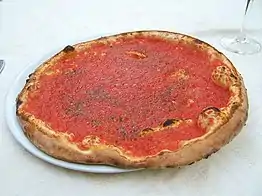
Sauces in Italian cuisine include:
- Agliata – Savory and pungent garlic sauce and condiment in Italian cuisine
- Agrodolce – Cooking method
- Arrabbiata sauce – Spicy tomato sauce for pasta
- Bagna càuda – Italian hot dish made from garlic and anchovies
- Bolognese ragù
- Checca sauce – Uncooked tomato sauce used with pasta
- Genovese sauce – Meat sauce
- Marinara sauce – Tomato sauce with herbs[38]
- Neapolitan sauce – Tomato-based sauce derived from Italian cuisine
- Pearà
- Pesto alla Genovese – Sauce made from basil, pine nuts, parmesan, garlic, and olive oil
- Ragù – Meat-based sauce in Italian cuisine[39]
- Neapolitan ragù – Italian meat sauce
- Ragù alla salsiccia – Tomato-based sauce with sausage
- Savore Sanguino
- Sugo all'amatriciana – Traditional Italian pasta sauce
- Sugo alla puttanesca – Neapolitan pasta dish
- Vincotto – Italian dessert paste
Jamaica
Sauces in Jamaican cuisine include:
- Jerk sauce – Style of cooking native to Jamaica
Japan
Sauces in Japanese cuisine include:
- Shottsuru – Japanese fish sauce
- Tare sauce – Family of Japanese sauces
- Ponzu – Japanese citrus-based condiment
- Umeboshi paste – Sour, pickled Japanese fruit, or Japanese pickled plum sauce
- Tonkatsu sauce – Japanese seasoning sauce
Korea

Sauces in Korean cuisine include:
- Korean soy sauce – East Asian liquid condiment[40]
Libya
Sauces in Libyan cuisine include:
- Filfel chuma – Israeli chili-garlic paste[41]
Malaysia
Sauces in Malaysian cuisine include:
- Cincalok – Malay salted shrimp condiment
Mexico
Sauces in Mexican cuisine include:
- Guacamole – Mexican avocado-based dip, spread, sauce, or salad[42]
- Mole – Mexican sauce and marinade[43]
- Pico de gallo – Mexican condiment
- Salsa macha
- Salsa Verde
- Salsa Roja
- Salsa borracha
Netherlands
Sauces in Dutch cuisine include:
- Fritessaus – Dutch condiment, usually served with French fries[44]
- Joppiesaus – sauce made from mayonnaise, onions and curry powder
Peru
Sauces in Peruvian cuisine include:
Crema de Rocoto Llatan Mayonesa de aceitunas (black olive mayonnaise)
Philippines
Sauces in Filipino cuisine include:
- Bagoong – Type of Philippine condiment[45]
- Banana ketchup – Sauce made from bananas
- Latik – Filipino dessert garnishing and condiment
- Chilli soy lime – a mixture of soy sauce, chopped bird's eye chillies, chopped onions, and calamansi lime juice—a traditional dipping sauce for grilled meats and seafood. The island of Guam has a similar sauce called finadene.
- Liver sauce – Filipino condiment spread made from liver, cereals, and spices – used primarily as a dipping sauce for lechon or whole roasted pig. Flavour is savoury, sweet and piquant, vaguely reminiscent of British style brown sauces but with a coarser texture.
Poland
Sauces in Polish cuisine include:
- Black Polish sauce (Polish: Czarny sos polski) – Based on honey, vinegar, ginger and black pepper. This sauce is not very common today.
- Ćwikła – Made of horseradish and cooked, minced beets. Very common during Easter . Served with various meats to eat with bread.
- Cranberry horseradish sauce – Consists of horseradish, minced cranberries, sour cream and mayonnaise.
- Dill sauce – Sauce which can be made hot or cold. Cold is made of dill, yoghurt and spices. Hot consists of roux, single/double cream or is starch thickened instead of a yoghurt. Hot version can be served with golabki or meatballs, cold one with cooked fish.
- Horseradish sauce – Made with sour cream, mayonnaise, lemon juice and minced horseradish. It may be eaten with hard-boiled eggs, bacon or baked/fried meats. It can also be put on sandwiches.
- Garlic sauce – Its main ingredients are garlic, mayonnaise, sour cream or yoghurt, herbs and spices. Similar, perhaps, to ranch dressing. It's eaten with pizza or used as a dressing to side salad (usually cauliflower or broccoli). It can be also made with only garlic and melted butter, to be tossed with asparagus, broad beans or green beans.
- Grey Polish sauce (Polish: Szary sos polski) – Consists of roux and beef, fish, or vegetable stock seasoned with wine or lemon juice. Additions include caramel, raisins, almonds, chopped onions, grated gingerbread or double cream.
- Hunter's sauce (Polish: sos myśliwski) – Tomato puree, onions, mushrooms, fried bacon and pickled cucumbers.
- Mizeria – Type of salad from Poland – A kefir or sour cream sauce or salad with thinly sliced cucumbers, sugar and herbs.
- Muślinowy sauce – A sauce perhaps similar to Hollandaise mixed with whipped cream or beaten egg whites.
- Polonaise – Sauce in Polish cuisine – Garnish made of melted butter, chopped boiled eggs, bread crumbs, salt, lemon juice and herbs. In Poland it's usually used as a dressing, served with cooked vegetables like green beans, cauliflower, broccoli or Brussels sprouts next to potatoes and meat.
- Salsza sauce (Polish: Salsza) – Sauce with butter, onion, parsley root, garlic, bay leaves, thyme, basil, vinegar, flour and wine.
- Velouté à la polonaise – Classic French sauce – A velouté sauce mixed with horseradish, lemon juice and sour cream.[46]
- Yellow Polish sauce (Polish: Żółty sos polski) – Made with wine, egg yolks, butter, sugar, cinnamon and saffron.
Portugal
Sauces in Portuguese cuisine include:
- Cebolada – An onion sauce of Portuguese origin used for fish and game.
- Cervejeira sauce – A beer sauce predominantly used for steaks.
- Escabeche sauce – A vinegar-based sauce predominantly used for fish.
- Francesinha sauce – Portuguese sandwich – A red or orange sauce, often tomato-based, that includes beer along with a variety of other possible ingredients.
Puerto Rico
Sauces in Puerto Rican cuisine include:
.jpg.webp)
- Adobo Mojado – Iberian culinary style
- Ajilimójili – Chili sauce from Puerto Rico
- Escabeche – Ibero-American fish, meat or vegetable dish Sauce –Pickling sauce made with chili, garlic, herbs, and vinegar primarily used for green banana, onions, root vegetables, chicken gizzard, and fish
- Ají de leche de coco – Spicy thick coconut milk and lime sauce
- Marie Rose sauce – British condiment – The sauce is made with sofrito, chilies, ketchup, sour orange, Worcestershire sauce, and mayonnaise
- Mojito Isleño – Puerto Rican condiment
- Mojo Criollo – Several types of sauces
- Pique
- Pique Verde – Puerto Rican green hot sauce
- Recaíto
- Sofrito – Cooked vegetable foundation for cooking
Romania
Sauces in Romanian cuisine include:
Russia

Sauces in Russian cuisine include:
Spain
Sauces in Spanish cuisine include:
Canary Islands
Sauces used in the cuisine of the Canary Islands include:
- Mojo – Several types of sauces
Catalonia

Sauces in Catalan cuisine include:
- Salvitxada – Sauce from Catalan cuisine
- Xató – Sauce in Catalan cooking
- Romesco – Catalan sauce of tomatoes, garlic, and nuts
- Alioli – Mediterranean sauce made of garlic and olive oil, optionally egg yolks and seasonings
Sweden
Sauces in Swedish cuisine include:
- Brunsås – Sauce made with brown meat stock
- Hovmästarsås - made with mustard and dill
- Lingonberry sauce
- Skagen sauce - made with shrimp, mayonnaise and other ingredients
Switzerland
Sauces in Swiss cuisine include:
- Café de Paris sauce – Butter-based sauce[48] – a butter-based sauce served with grilled beef
Thailand
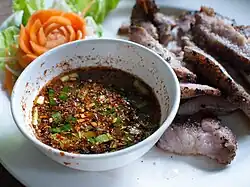
Sauces in Thai cuisine include:
- Nam chim – Thai sauce
- Nam phrik – Thai chili sauce
- Sriracha sauce – Thai hot sauce[49]
- Sweet chili sauce – Condiment primarily used as a dip
United Kingdom

Sauces in British cuisine include:
- Albert sauce – British sauce, made of grated horseradish in a clear bouillon, thickened with cream and egg yolks, and spiced with a little prepared mustard diluted in vinegar
- Apple sauce – Purée made from apples
- Bread sauce – Sauce made with milk and bread crumbs
- Brown sauce – Condiment served with food in the UK and Ireland
- Cheddar sauce – Type of sauce made with cheddar cheese
- Cumberland sauce – Fruit sauce (Oxford sauce)
- Gravy – Sauce made from the juices of meats
- Horseradish sauce – Species of flowering plants in the cabbage family Brassicaceae
- Marie Rose sauce – British condiment
- Mint sauce – Sauce made of chopped mint
- Mushroom sauce – White or brown sauce prepared with mushrooms
- Onion gravy – type of gravy prepared with onions
- Parsley sauce – cream sauce seasoned with parsley
- Redcurrant sauce – English condiment
- Shrewsbury sauce – English savoury sauce
- Tewkesbury mustard
- Whisky sauce
- White sauce – Sauce of the Italian and French cuisines
- Worcestershire sauce – English fermented condiment
- Wow-Wow sauce, also known as Bow Wow Sauce
United States

Sauces in the cuisine of the United States include:
- Alfredo sauce – Italian pasta dish with butter and cheese
- Barbecue sauce – Sauce used as a marinade, basting, topping, or condiment
- Brown gravy – Sauce made from the juices of meats
- Buffalo sauce – American dish of spicy chicken wings
- Cincinnati chili – Spiced meat sauce used as a topping for spaghetti
- Coffee sauce – Culinary sauce that includes coffee
- Comeback sauce – Sauce for fried food from Mississippi
- Coney sauce – American fast food item[50]
- Cranberry sauce – Sauce or relish made from cranberries
- Duck sauce – American Chinese condiment with a translucent orange appearance
- Étouffée sauce – American seafood and rice dish
- Henry Bain sauce – American condiment for meats
- Huli-huli sauce – Hawaiian chicken dish
- Lobster sauce – type of sauce used in American-Chinese and Canadian-Chinese cuisine, made of chicken broth, garlic, ginger, fermented black beans, eggs, and cornstarch; does not contain any lobster, despite the name
- Mumbo sauce – American regional sauce
- Michigan sauce – Style of hot dog
- Old Sour
- Red-eye gravy – Type of gravy
- Remoulade – Mayonnaise-based cold sauce
- Sausage gravy – Breakfast dish from the Southern United States
- Tomato sauce – Sauce made primarily from tomatoes
- Vodka sauce – Pasta dish with vodka, cream and tomato sauce
Vietnam
Sauces in Vietnamese cuisine include:
Dipping sauces are a mainstay of many Vietnamese dishes. Some of the commonly used sauces are:[51]
- Mắm tôm – Fermented condiment - Fermented shrimp sauce
- Mắm Kho Quẹt - Caramalised, vegetable dip
- Mắm Nêm
- Muối ớt xanh sữa đặc chấm hải sản - Green chili with seafood sauce
- Nước chấm – Vietnamese dipping sauce
- Nước mắm chấm - Salty fish sauce
- Nước mắm đường - Sweet fish sauce
- Nước mắm gừng - Ginger fish sauce
- Tương - fermented bean paste
See also
- Chutney – South Asian condiments made of spices, vegetables, and fruit
- Compound butter – Butter mixed with other ingredients
- Condiment – Substance added to food for flavor
- Deglazing (cooking) – Cooking technique to create a sauce
- Dipping sauce – Type of sauce
- List of dips – Type of sauce
- Fermented bean paste – Fermented foods made from ground soybeans
- Fondue – Swiss melted cheese dish
- Gastrique – Caramelized sugar, deglazed with vinegar
- List of condiments
- List of dessert sauces
- List of fish sauces
- List of hot sauces
- List of mayonnaises
- List of meat-based sauces
- List of syrups
- Marination – Process of soaking foods in a seasoned, often acidic, liquid before cooking
- Outline of food preparation – Overview of and topical guide to food preparation
- Reduction (cooking) – process of thickening and intensifying the flavor of a liquid mixture such as a soup, sauce, wine, or juice by simmering or boiling
- Relish – Cooked, pickled, or chopped vegetable or fruit used as a condiment
- Sauce boat – Low lipped vessel in which sauce is served
- Saucery – Medieval office of sauce preparation
- Saucier – Type of chef
- Soup – Primarily liquid food
- Spread (food) – Food that is spread onto bread
- Sweet bean paste – bean paste used in several Asian cuisines
References
- ↑ Bruce Bjorkman (1996). The Great Barbecue Companion: Mops, Sops, Sauces, and Rubs. p. 112. ISBN 0-89594-806-0.
- ↑ Peterson, J. (2017). Sauces: Classical and Contemporary Sauce Making. Houghton Mifflin Harcourt. p. 148. ISBN 978-0-544-81982-5. Retrieved December 16, 2020.
- ↑ Peterson, J. (2017). Sauces: Classical and Contemporary Sauce Making, Fourth Edition. HMH Books. p. 154. ISBN 978-0-544-81983-2. Retrieved December 16, 2020.
- ↑ Whitehead, J. (1889). The Steward's Handbook and Guide to Party Catering. The Steward's Handbook and Guide to Party Catering. J. Anderson & Company, printers. p. 273. Retrieved June 15, 2017.
- ↑ Escoffier, Auguste (1969). The Escoffier Cookbook. Crown Publishers, Inc.
- ↑ Corriher, Shirley (1997). "Ch. 4: sauce sense". Cookwise, the Hows and Whys of Successful Cooking (1st ed.). New York: William Morrow & Company, Inc. ISBN 0-688-10229-8.
- ↑ Prosper Montagné (1961). Charlotte Snyder Turgeon; Nina Froud (eds.). Larousse gastronomique: the encyclopedia of food, wine & cookery. Crown Publishers. p. 861. ISBN 0-517-50333-6. Retrieved April 16, 2012.
- ↑ Beck, Bertholle and Child, pp. 94−95
- ↑ "Béchamel definition". Merriam-Webster.
- ↑ Victor Ego Ducrot (1998), Los sabores de la Patria, Grupo Editorial Norma. (in Spanish)
- ↑ Carrington, Sean; Fraser, Henry C. (2003). "Pepper sauce". A~Z of Barbados Heritage. Macmillan Caribbean. p. 150. ISBN 0-333-92068-6.
- ↑ D&L Archived August 19, 2014, at the Wayback Machine, La William
- ↑ Vos, Heidemarie (2010). Passion of a Foodie. p. 591. ISBN 978-1-934925-63-8.
- ↑ Fuller and Renold, recipe no. 54
- ↑ Hering, p. 37
- 1 2 Saulnier, p. 17
- ↑ Fuller and Renold, recipe no. 80
- ↑ Hering, p. 46
- ↑ Fuller and Renold, recipe no. 81
- ↑ Fuller and Renold, recipe no. 82
- ↑ Saulnier, p. 6
- ↑ Saulnier, p. 18
- ↑ Fuller and Renold, recipe no. 16
- 1 2 3 Saulnier, p. 18
- ↑ Fuller and Renold, recipe no. 29
- ↑ Escoffier, A. (1979) [1921]. Le guide culinaire=The complete guide to the art of modern cookery: the first complete translation into English (1st American ed.). New York: Mayflower Books. p. 64. ISBN 0-8317-5478-8. Retrieved 16 December 2020.
- ↑ Saulnier, p. 20
- ↑ Fuller and Renold, recipe no. 34
- 1 2 Saulnier, p. 21
- ↑ Saulnier, p. 22
- ↑ Beck, Bertholle and Child, p. 184
- ↑ Saulnier, p. 23
- 1 2 Saulnier, p. 23
- ↑ Hering, p. 54
- 1 2 3 4 Saulnier, p. 24
- ↑ Beck, Bertholle and Child, p. 51
- ↑ Escoffier, Auguste (1903). Le guide culinaire, aide-mémoire de cuisine pratique. Par A. Escoffier. Emile Colin (imprimerie de Lagny). pp. 132–135.
- ↑ Elizabeth David, Italian Food (1954, 1999), p 319, and John Dickie, Delizia! The Epic History of the Italians and Their Food, 2008, p. 162.
- ↑ Accademia Italiana della Cuisine, La Cucina - The Regional Cooking of Italy (English translation), 2009, Rizzoli, ISBN 978-0-8478-3147-0
- ↑ Jung, Soon Teck & Kang, Seong-Gook (2002). "The Past and Present of Traditional Fermented Foods in Korea". Archived from the original on December 23, 2007. Retrieved January 7, 2008.
- ↑ Gur, Jana; (et al.) (2007). The Book of New Israeli Food: A Culinary Journey. Schocken Books. pg. 295. ISBN 9780805212242
- ↑ Smith, Andrew F. (May 1, 2007). The Oxford companion to American food and drink. Oxford University Press. p. 29. ISBN 978-0-19-530796-2. Retrieved March 14, 2012.
- ↑ Hall, Phil (March 19, 2008). "Holy Mole". The Guardian. London. Retrieved August 20, 2010.
- ↑ John B. Roney (2009). Culture and Customs of the Netherlands. ABC-CLIO, LLC. p. 133. ISBN 978-0-313-34808-2. Retrieved May 21, 2012.
- ↑ Eve Zibart (2001). The Ethnic Food Lover's Companion: A Sourcebook for Understanding the Cuisines of the World. Menasha Ridge Press. p. 270. ISBN 978-0-89732-372-7.
- ↑ "À la Polonaise". CooksInfo. Retrieved February 28, 2021.
- ↑ "Definition of mujdei" (in Romanian). DEX online.
- ↑ "John Lichfield: Our Man In Paris: Revealed at last: how to make the French queue". The Independent. July 2, 2007. Retrieved September 5, 2012.
- ↑ Edge, John (May 19, 2009). "A Chili Sauce to Crow About". New York Times. Retrieved May 20, 2009.
- ↑ Cameron, J.N. (2015). Seven Neighborhoods in Detroit: Recipes from the City. Beneva Publishing. p. 148. ISBN 9780996626101.
- ↑ "10 Popular Vietnamese Dipping Sauces". Vietnamese Home Cooking Recipes. Retrieved 2020-12-21.
Book sources
- Beck, Simone; Louisette Bertholle; Julia Child (2012) [1961]. Mastering the Art of French Cooking, Volume One. London: Particular. ISBN 978-0-241-95339-6.
- Fuller, John; Edward Renold (1992). The Chef's Compendium of Professional Recipes. Oxford: Butterworth-Heinemann. ISBN 978-0-7506-0490-1.
- Hering, Richard (1989). Hering's Dictionary of Classical and Modern Cookery (eleventh ed.). London: Virtue. ISBN 978-3-8057-0307-9.
- Saulnier, Louis (1978). Le Répertoire de la Cuisine (fourteenth ed.). London: Jaeggi. OCLC 1086737491.
Further reading
- Sokolov, Raymond (1976). The Saucier's Apprentice. Knopf. ISBN 0-394-48920-9.
- Corriher, Shirley (1997). "Ch. 4: sauce sense". Cookwise, the Hows and Whys of Successful Cooking (1st ed.). New York: William Morrow & Company, Inc. ISBN 0-688-10229-8.
- Murdoch (2004) Essential Seafood Cookbook Seafood sauces, p. 128–143. Murdoch Books. ISBN 9781740454124
- Brandau, Mark (August 30, 2012). "Restaurant chains experiment with sauces to add flavor". Nation's Restaurant News magazine. Retrieved September 5, 2012.
- "Emerging Sauces". Foodservice Research Institute. 2011. Archived from the original on March 4, 2016. Retrieved September 5, 2012.
